Delayed-Expansion Capsule Sealing Material for Coal Mine Overburden Isolated Grouting
Abstract
:1. Introduction
2. Sealing Mechanism
3. Materials and Properties
3.1. Test Methods
3.2. Expansion Characteristics
3.3. Flow Characteristics
4. Preparation and Properties of Sealing Material
4.1. Preparation
- (a)
- SAP raw material with core sizes of 20, 40, and 60 mesh;
- (b)
- The ratio of the coated wall material to the capsule material is 20%, 30%, and 50%.
4.2. Properties
5. Sealing Effectiveness
5.1. Experimental Design
5.2. Role of SAP Materials
5.3. Role of Fracture Aperture
6. Conclusions
Author Contributions
Funding
Institutional Review Board Statement
Informed Consent Statement
Data Availability Statement
Conflicts of Interest
References
- Li, H.; Guo, G.; Zha, J.; Wang, T.; Chen, Y.; Yuan, Y.; Huo, W. A New Method of Regional Mining Subsidence Control for Sustainable Development in Coal Areas. Sustainability 2023, 15, 7100. [Google Scholar] [CrossRef]
- Xuan, D.; Li, J.; Zheng, K.; Xu, J. Experimental study of slurry flow in mining-induced fractures during longwall overburden grout injection. Geofluids 2020, 2020, 8877616. [Google Scholar] [CrossRef]
- Xuan, D.; Xu, J.; Zhu, W. Backfill mining practice in China coal mines. J. Mines Met. Fuels 2013, 61, 225–234. [Google Scholar]
- Li, S.; Yu, L.; Dan, Z.; Yin, T.; Chen, J. The Recent Progress China Has Made in Mining Method Transformation, Part I: Shrinkage Method Transformed into Backfilling Method. Appl. Sci. 2024, 14, 10033. [Google Scholar] [CrossRef]
- Li, S.; Xiang, Z.; Dan, Z.; Yin, T.; Chen, J. The Recent Progress China Has Made in Mining Method Transformation: Part II Sublevel Caving Method Transformed into Backfilling Method. Appl. Sci. 2024, 14, 9732. [Google Scholar] [CrossRef]
- Li, J.; Xuan, D.; Xu, J.; Dong, Z.; Wang, C. Compaction Response of Mining-Induced Rock Masses to Longwall Overburden Isolated Grouting. Minerals 2023, 13, 633. [Google Scholar] [CrossRef]
- Ma, C.; Xuan, D.; Xu, J.; Li, J. Experimental Study on Water Reduction Modification and Efficient Utilization of Coal-Based Solid Waste Slurry. Adv. Civ. Eng. 2024, 2024, 5642217. [Google Scholar] [CrossRef]
- Xu, J.; Xuan, D. Cost Investigation of the Coalmine Subsidence Control Technology of Isolated Overburden Grout Injection. Geotech. Geol. Eng. 2019, 37, 4251–4258. [Google Scholar] [CrossRef]
- Xu, J.; Xuan, D.; He, C. Innovative backfilling longwall panel layout for better subsidence control effect—Separating adjacent subcritical panels with pillars. Int. J. Coal Sci. Technol. 2014, 1, 297–305. [Google Scholar] [CrossRef]
- Xuan, D.; Xu, J. Grout injection into bed separation to control surface subsidence during longwall mining under villages: Case study of Liudian coal mine, China. Nat. Hazards 2014, 73, 883–906. [Google Scholar] [CrossRef]
- Shao, C.; Zhu, G.; Zhang, Q.; Duan, S.; Liu, R. Experimental study on sealing effect of cement–sodium silicate slurry in rock fracture with flowing seawater. Tunn. Undergr. Space Technol. 2024, 155, 106173. [Google Scholar] [CrossRef]
- Zhang, X.; Wang, E. Study on the Gelation Process and Mechanical Properties of Organic Polymer Grouting Materials Applied to Fissure Sealing in Underground Mines. Polymers 2024, 16, 446. [Google Scholar] [CrossRef] [PubMed]
- Guo, S.; Forooshani, P.K.; Dai, Q.; Lee, B.P.; Si, R.; Wang, J. Design of pH-responsive SAP polymer for pore solution chemistry regulation and crack sealing in cementitious materials. Compos. B Eng. 2020, 199, 108262. [Google Scholar] [CrossRef]
- Islam, U.; Waseem, A. Fracture properties and self-healing assessment of superabsorbent polymer modified hybrid fibre concrete. J. Build. 2024, 96, 2352–2364. [Google Scholar] [CrossRef]
- Yang, J.; Duan, X.; Qiu, J.; Su, L.; He, X. Research progress of superabsorbent resin hydrogel for crack self-plugging of cement-based materials. J. Chin. Ceram. Soc. 2023, 51, 3015–3024. [Google Scholar]
- Belie, N.; Tittelboom, K.; Snoeck, D. Smart additives for self-sealing and self-healing concrete. MRS Proc. 2012, 1488, imrc12-1488. [Google Scholar] [CrossRef]
- Snoeck, D.; Van, K. Tittelboom. Self-healing cementitious materials by the combination of microfibres and superabsorbent polymers. J. Intell. Mater. Syst. Struct. 2014, 25, 13–24. [Google Scholar] [CrossRef]
- Li, D.; Chen, B.; Chen, X. Synergetic effect of superabsorbent polymer (SAP) and crystalline admixture (CA) on mortar macro-crack healing. Constr. Build. Mater. 2020, 247, 1185–1196. [Google Scholar] [CrossRef]
- Hassi, S.; Javanmardi, A.; Menu, B. Effect of super absorbent polymers on the self-healing capability of macrocracked ultra-high performance concrete under highly aggressive environments. Colloids Surf. A 2024, 705, 135540. [Google Scholar] [CrossRef]
- Lefever, G.; Snoeck, D.; Aggelis, D. Evaluation of the self-healing ability of mortar mixtures containing superabsorbent polymers and nanosilica. Ind. Organ. Psychol. 2020, 13, 380. [Google Scholar] [CrossRef]
- Feng, J.; Dong, H.; Wang, R. A novel capsule by poly (ethylene glycol) granulation for self-healing concrete. Cem. Concr. Res. 2020, 133, 106053. [Google Scholar] [CrossRef]
- Chindasiriphan, P.; Subwilai, N.; Intarasoontron, J. Synergistic effects of microencapsulated bacterial spores and superabsorbent polymer on self-healing performance in mortar. Constr. Build. Mater. 2024, 414, 135005. [Google Scholar] [CrossRef]
- Pelto, J.; Leivo, M.; Gruyaert, E.; Debbaut, B.; Snoeck, D.; De Belie, N. Application of encapsulated superabsorbent polymers in cementitious materials for stimulated autogenous healing. Smart Mater. Struct. 2017, 26, 235–241. [Google Scholar] [CrossRef]
- Lauch, K.; Desmettre, C.; Charron, J. Self-healing of concrete containing different admixtures under laboratory and long-term real outdoor expositions based on water permeability test. Constr. Build. Mater. 2022, 324, 154–166. [Google Scholar] [CrossRef]
- Chang, L.; Xu, L.; Liu, Y. Superabsorbent polymers used for agricultural water retention. Polym. Test. 2021, 94, 107021. [Google Scholar] [CrossRef]
- Behrouzi, M.; Moghadam, P. Synthesis of a new superabsorbent copolymer based on acrylic acid grafted onto carboxymethyl tragacanth. Carbohydr. Polym. 2018, 202, 227–235. [Google Scholar] [CrossRef]
- Lu, J.; Zhang, S.; Zhang, L.; Wang, C.; Min, C. Preparation and Properties of Hollow Glass Microspheres/Dicyclopentadiene Phenol Epoxy Resin Composite Materials. Materials 2023, 16, 3768. [Google Scholar] [CrossRef]
- Su, A.; Wang, Y.; Wang, R.; Chu, Y.; Xu, W.; Tian, Q.; Yao, S.; Meng, Q.; Wang, W. Effects of superabsorbent polymers on the pore structure and coefficient of thermal expansion of cementitious materials. Case Stud. Constr. Mater. 2024, 21, 537–544. [Google Scholar] [CrossRef]
- Sujitha, S.; Ramesh, B.; Xavier, R. Investigation of Bi-functionalized Clay-Superabsorbent Polymer Nanocomposite for Improved Mechanical and Durability Properties of Cementitious Materials. Arab. J. Sci. Eng. 2024, 20, 1–24. [Google Scholar] [CrossRef]
- Kalinowski, M.; Woyciechowski, P. The Influence of Total Water-To-Cement Ratio on the Mechanical Properties of Cementitious Composites Internally Cured with Polyacrylic Superabsorbent Polymers (SAP). Struct. Environ. 2024, 16, 48–60. [Google Scholar] [CrossRef]
- Krzysztof, S.; Grzegorz, W.; Krzysztof, W. Modelling of Resinous Material Filling Expansion Joints in Reinforced Concrete Structures. Materials 2023, 16, 2011. [Google Scholar] [CrossRef] [PubMed]
- Ogah, O.; Madu, O.; Timothy, J.; Olivia, N.; Ikelle, I. Characterization of Water Absorption, Thickness Swelling and Diffusion Coefficient of Natural Fiber/EpoxyBio-Composites for Applications in Aquatic Environment. J. Appl. Phys. Sci. Int. 2024, 45, 1–10. [Google Scholar] [CrossRef]
- Woyciechowski, P.; Kalinowski, M. The Influence of Dosing Method and Material Characteristics of Superabsorbent Polymers (SAP) on the Effectiveness of the Concrete Internal Curing. Materials 2018, 11, 1600. [Google Scholar] [CrossRef] [PubMed]
- Invernizzi, M.; Natale, G.; Levi, M.; Turri, S.; Griffini, G. UV-Assisted 3D Printing of Glass and Carbon Fiber-Reinforced Dual-Cure Polymer Composites. Materials 2016, 9, 583. [Google Scholar] [CrossRef]
- Kaptan, K.; Cunha, S.; Aguiar, J. A Review of the Utilization of Recycled Powder from Concrete Waste as a Cement Partial Replacement in Cement-Based Materials: Fundamental Properties and Activation Methods. Appl. Sci. 2024, 14, 9775. [Google Scholar] [CrossRef]
- Yang, J.; Li, M.; Ma, S.; Xiao, M.; Jin, J. Eco-Friendly Shield Muck-Incorporated Grouting Materials: Mix Optimization and Property Evaluation for Silty Clay Tunnel Construction. Appl. Sci. 2024, 14, 8830. [Google Scholar] [CrossRef]
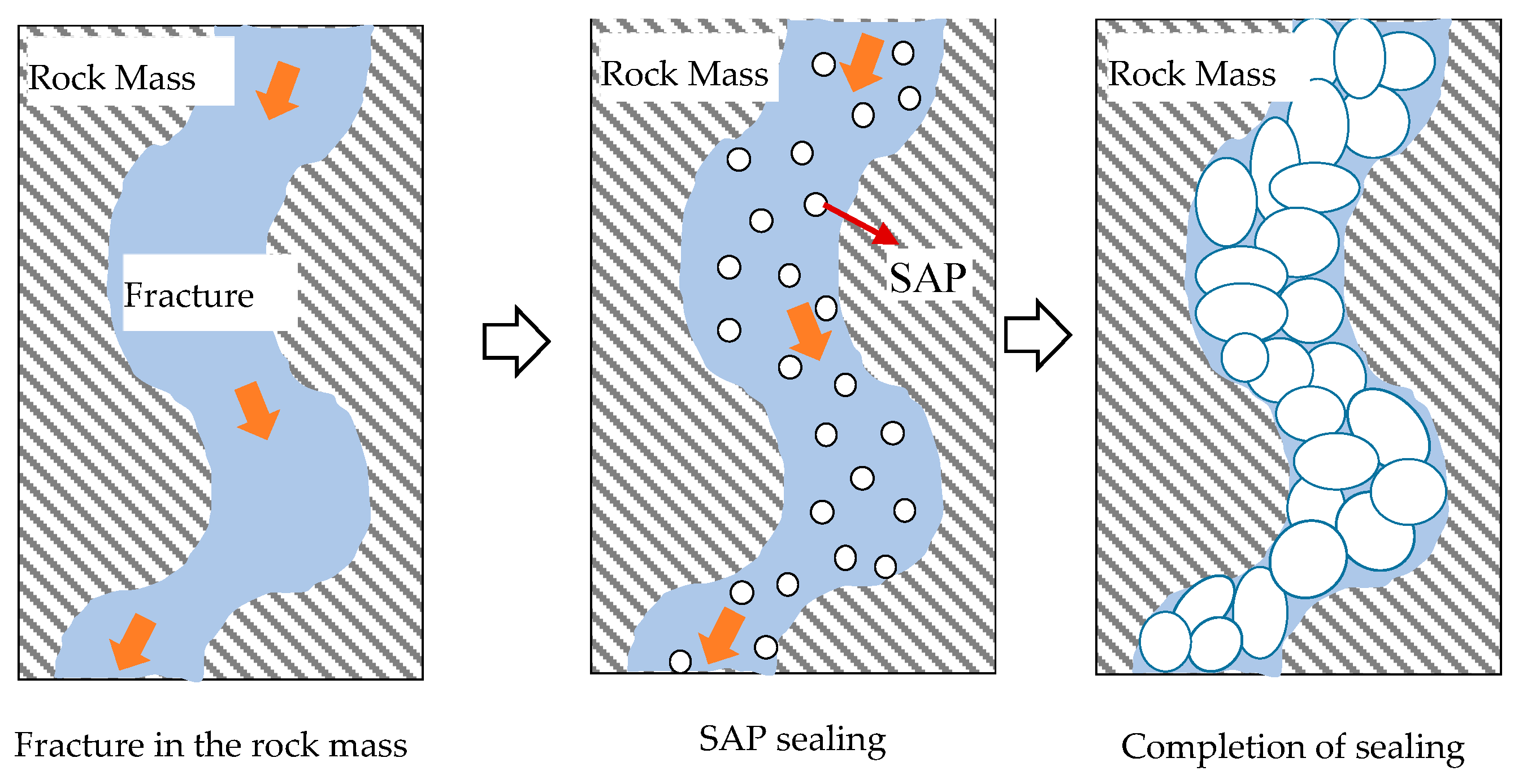

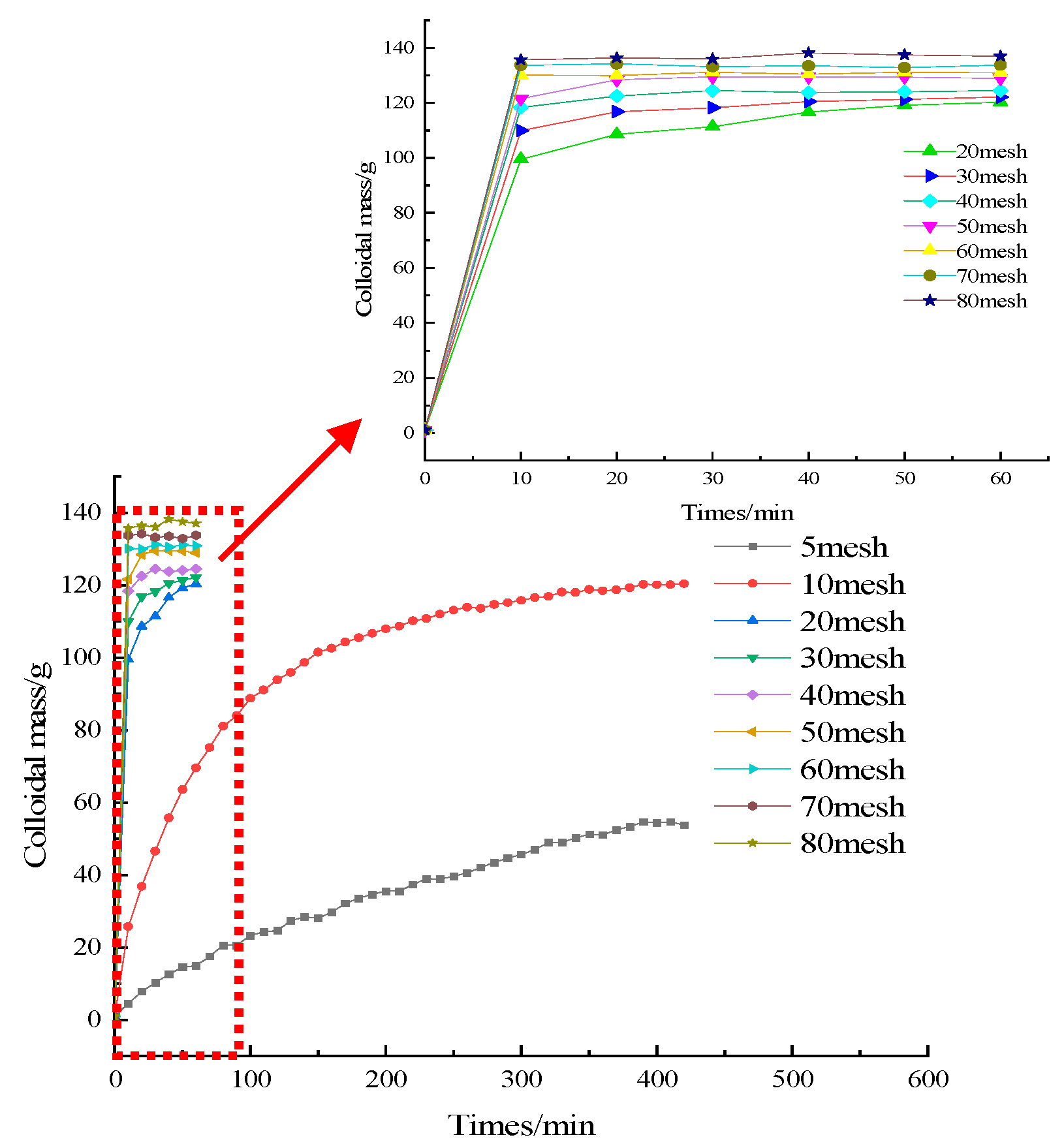
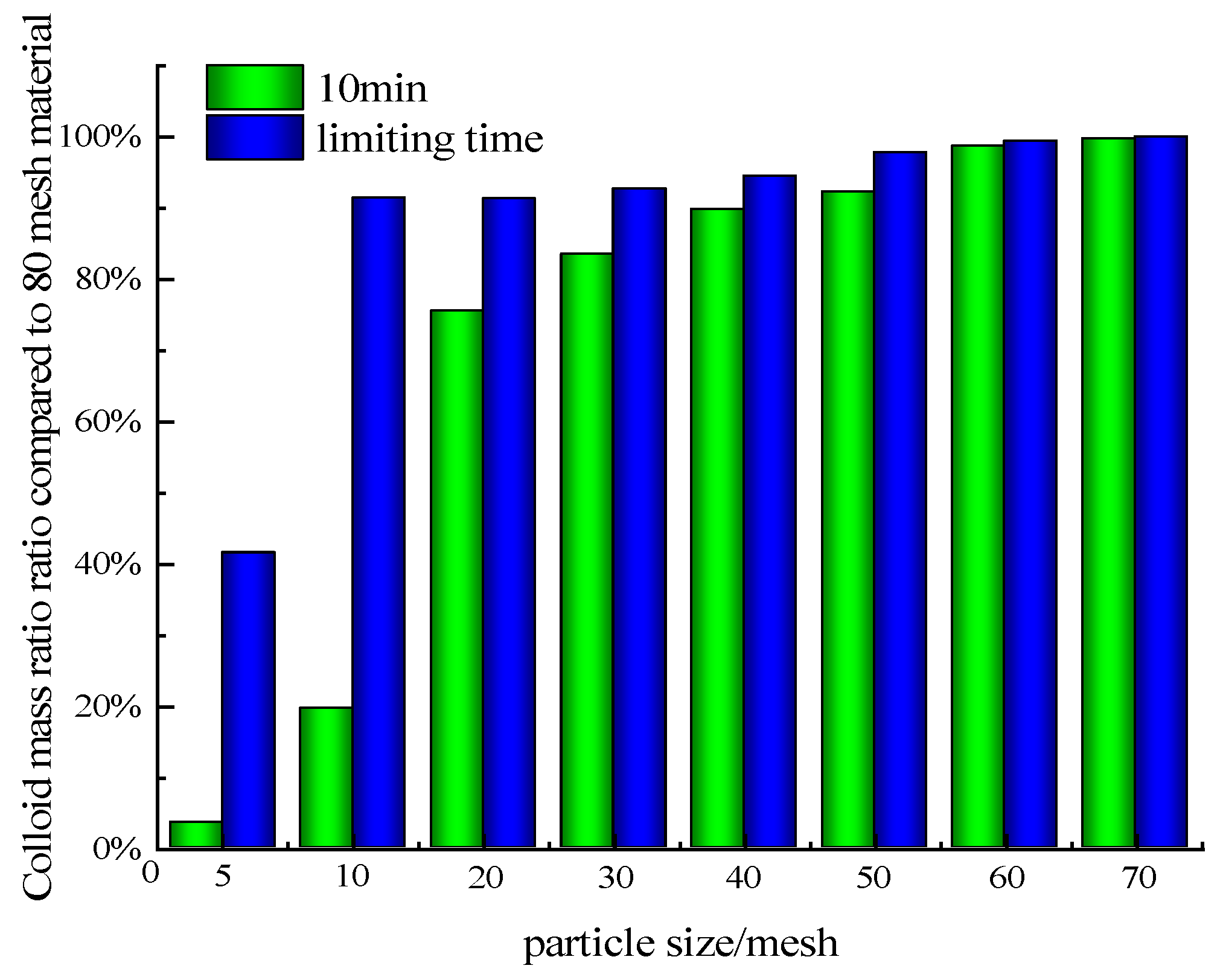
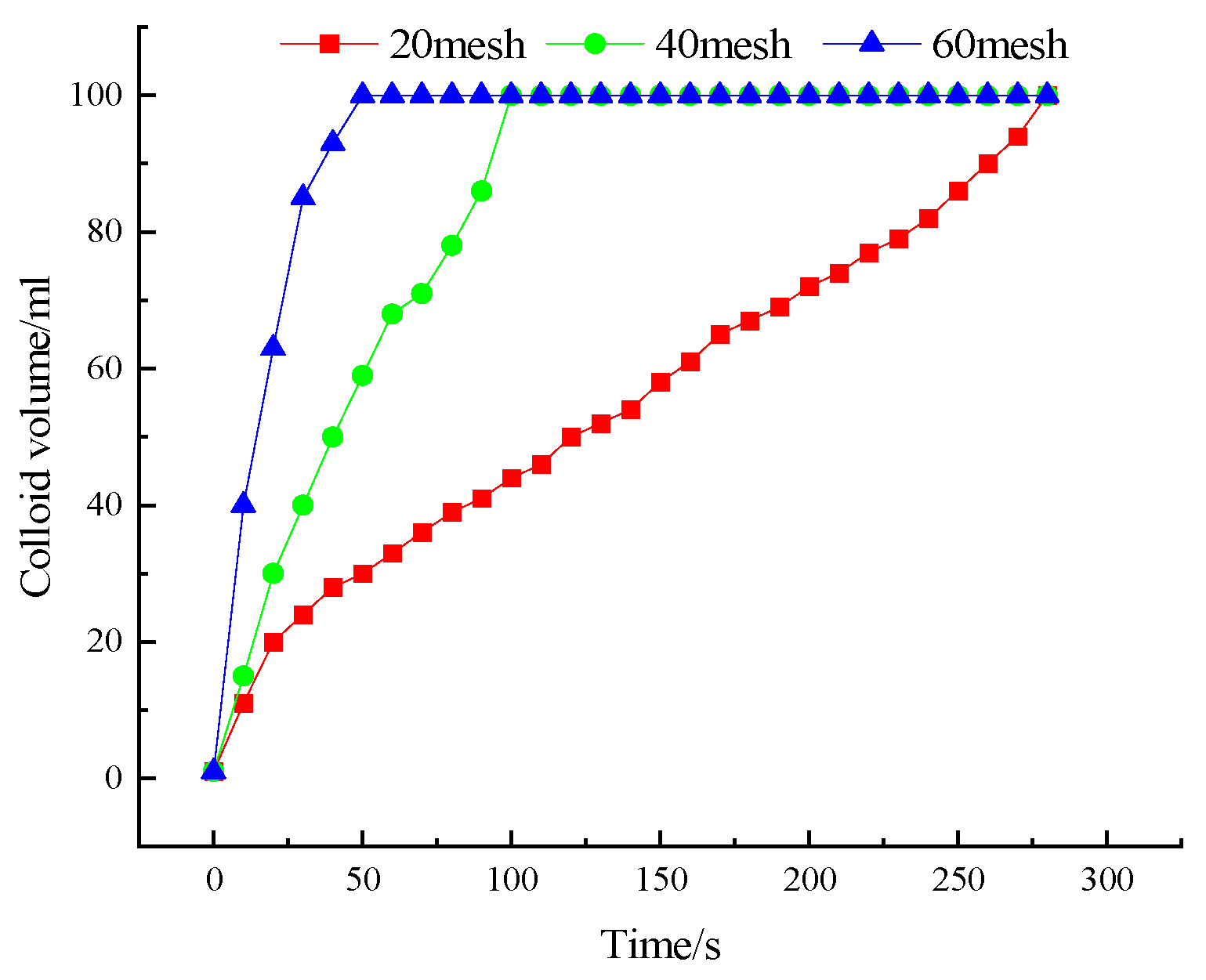

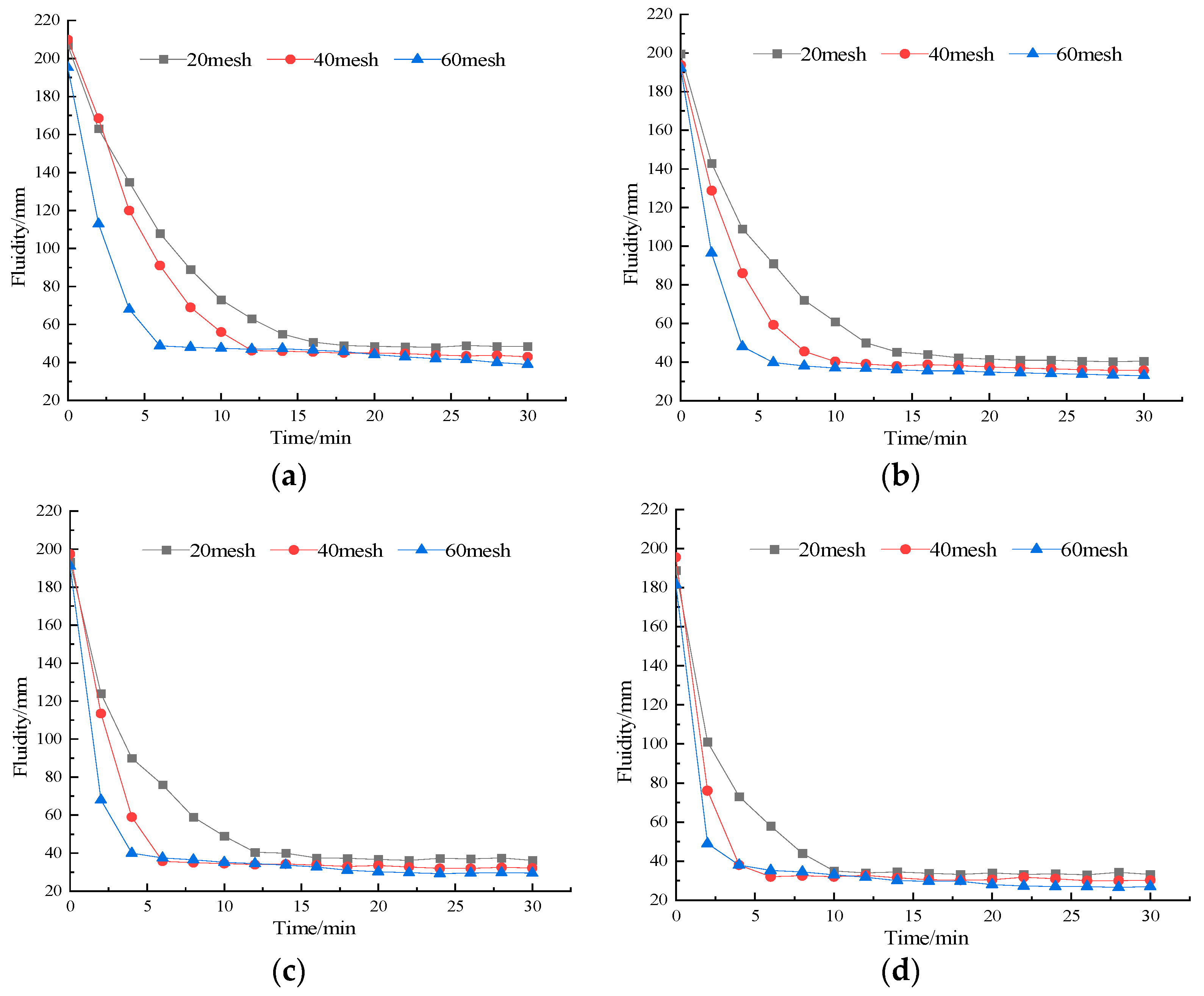

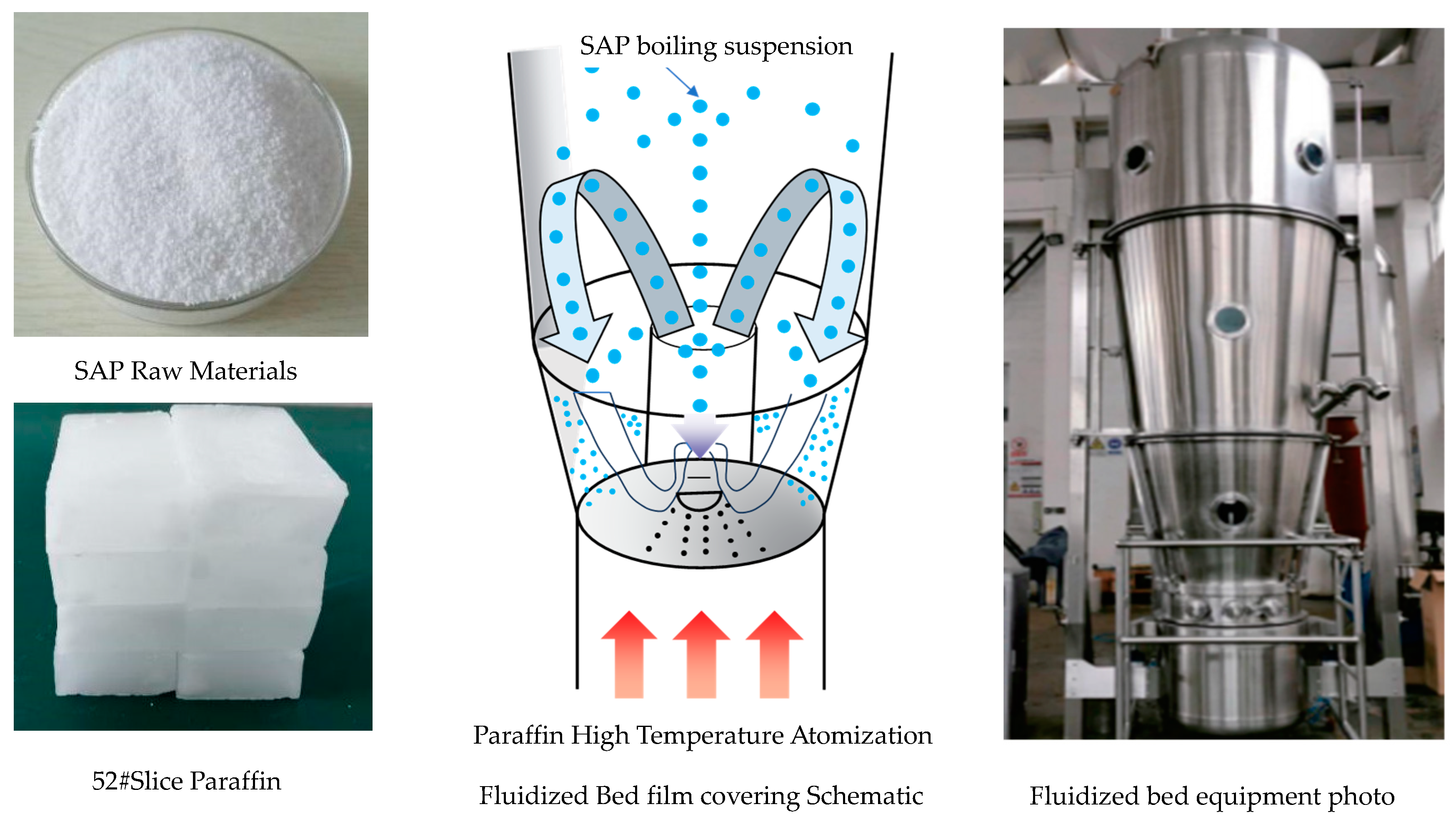
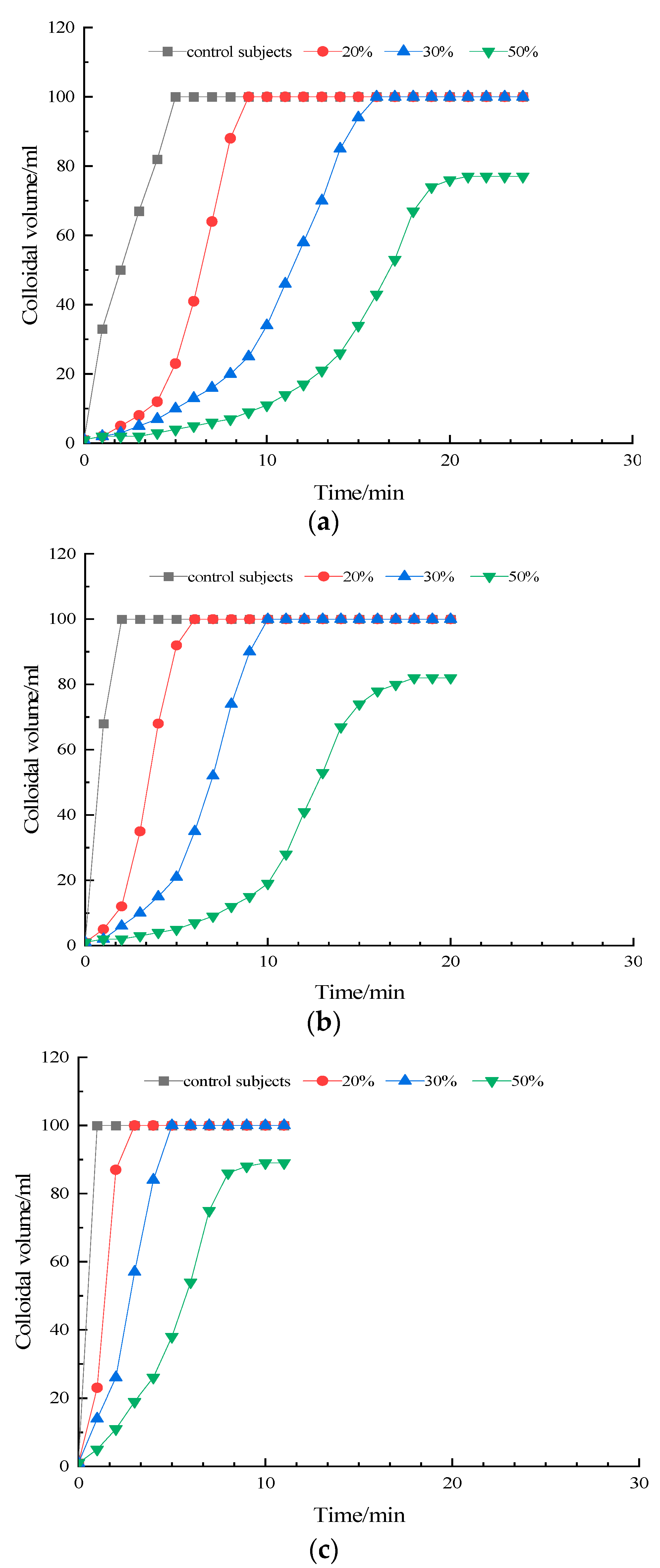

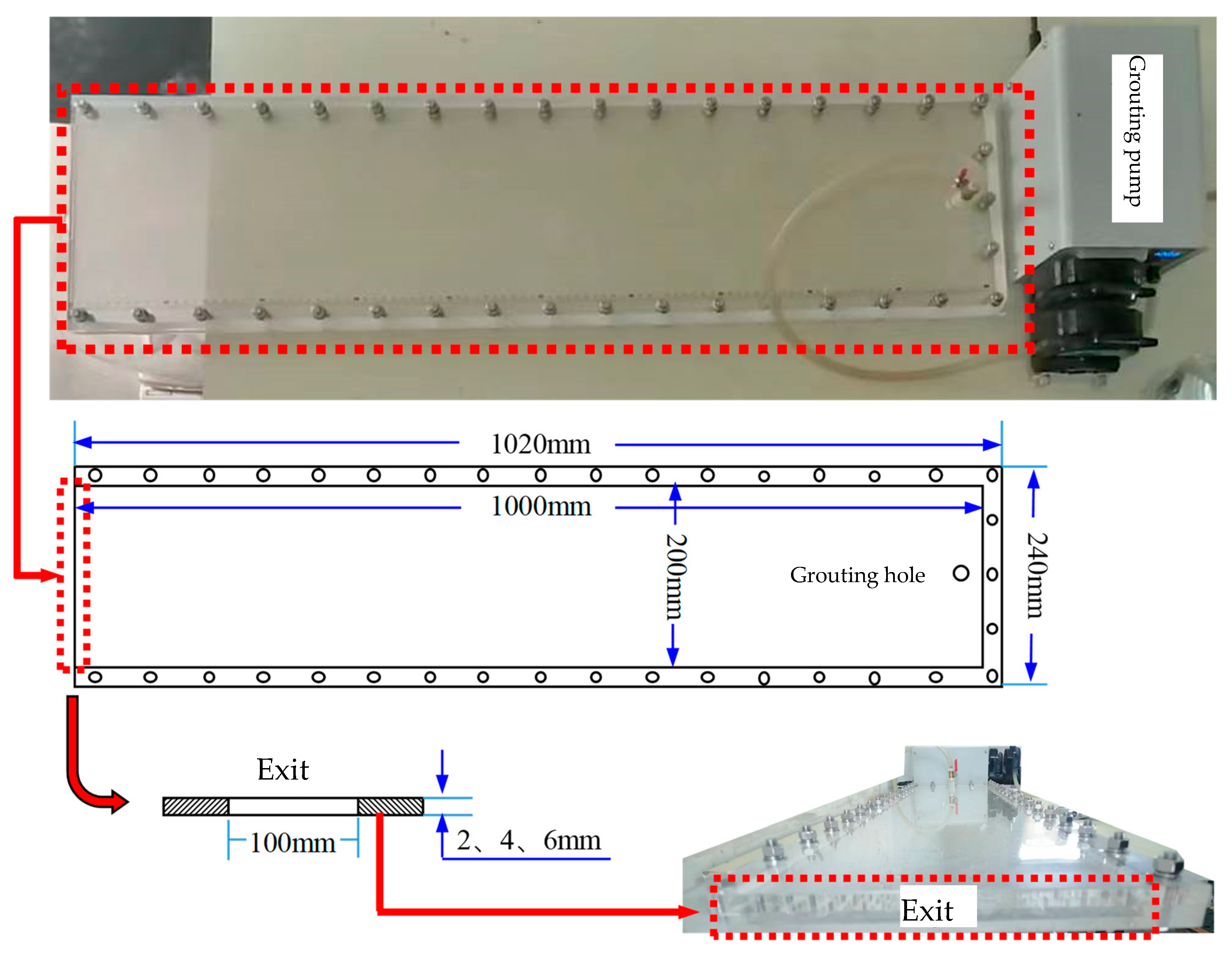
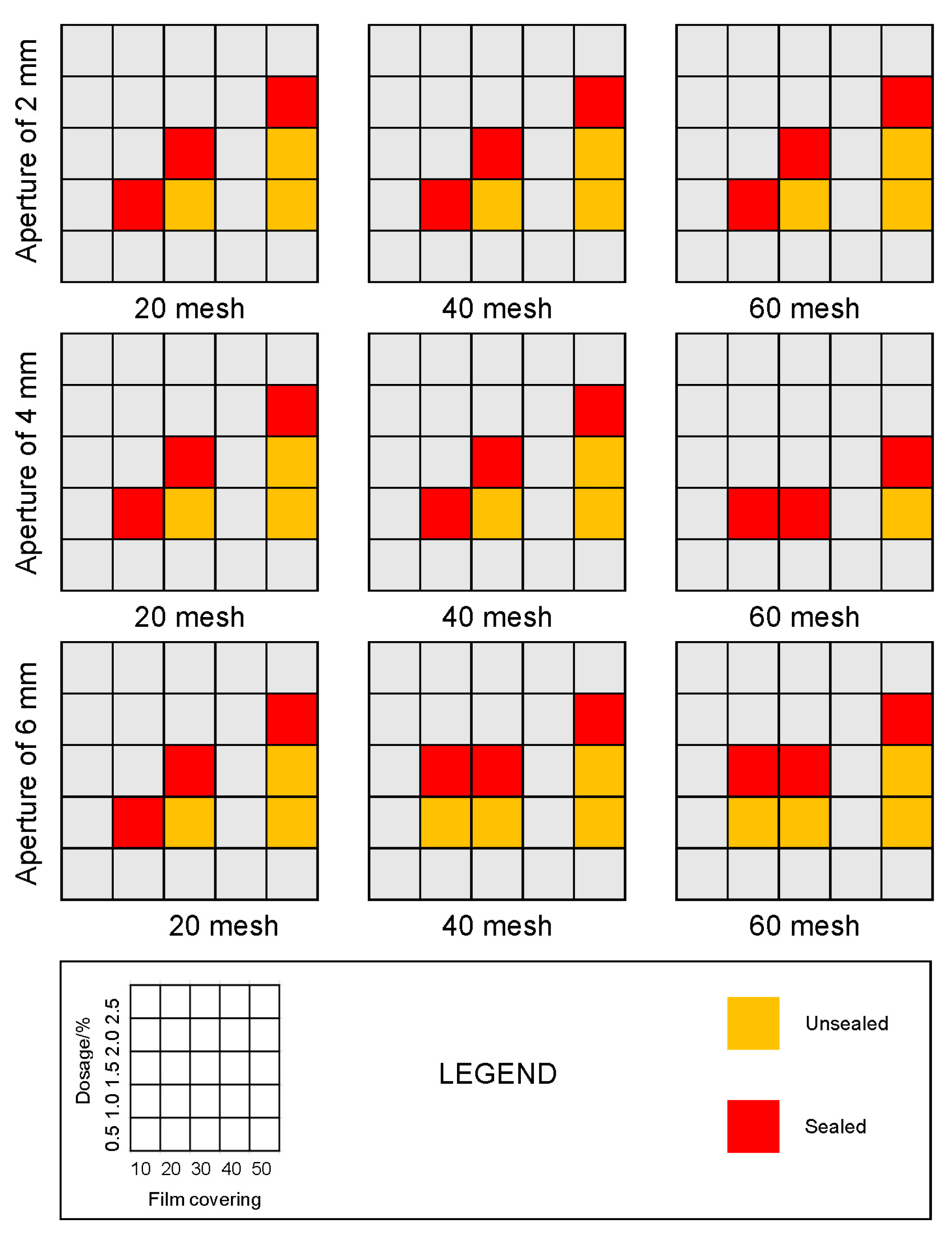

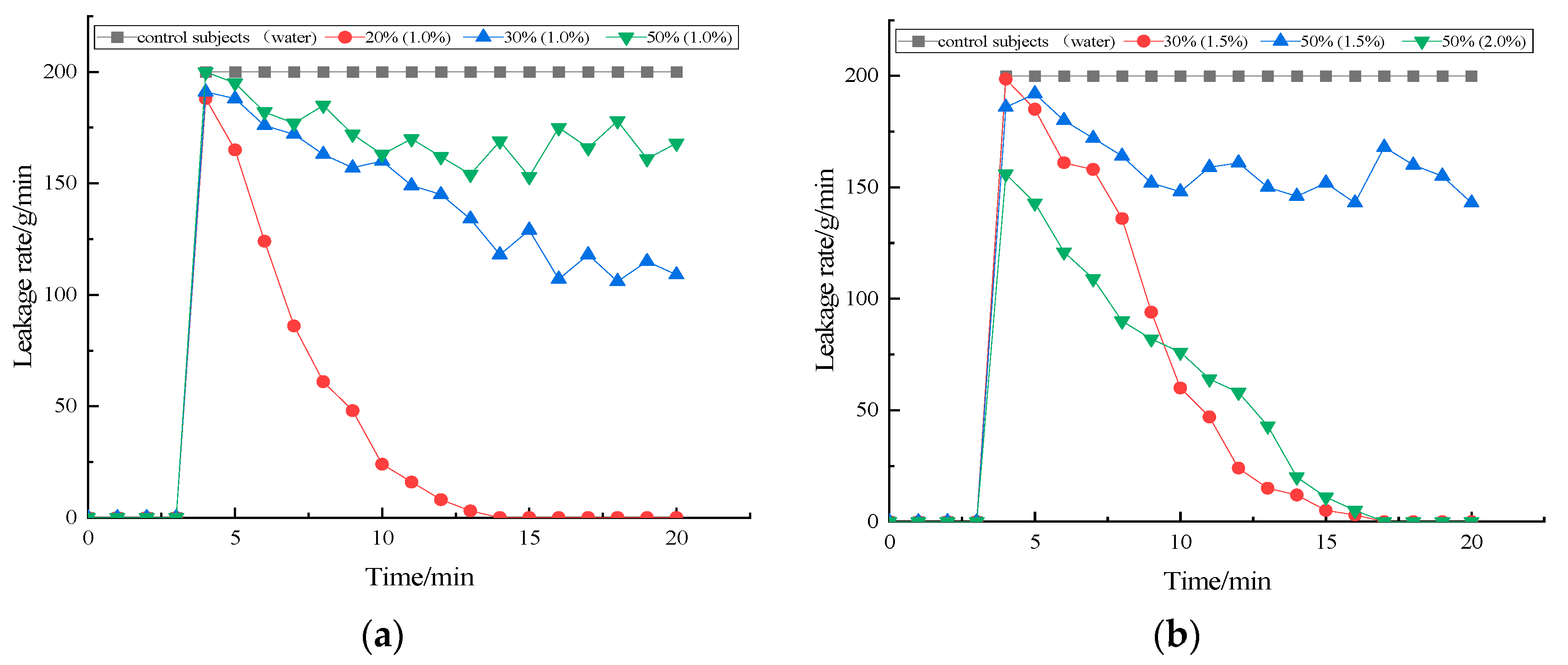
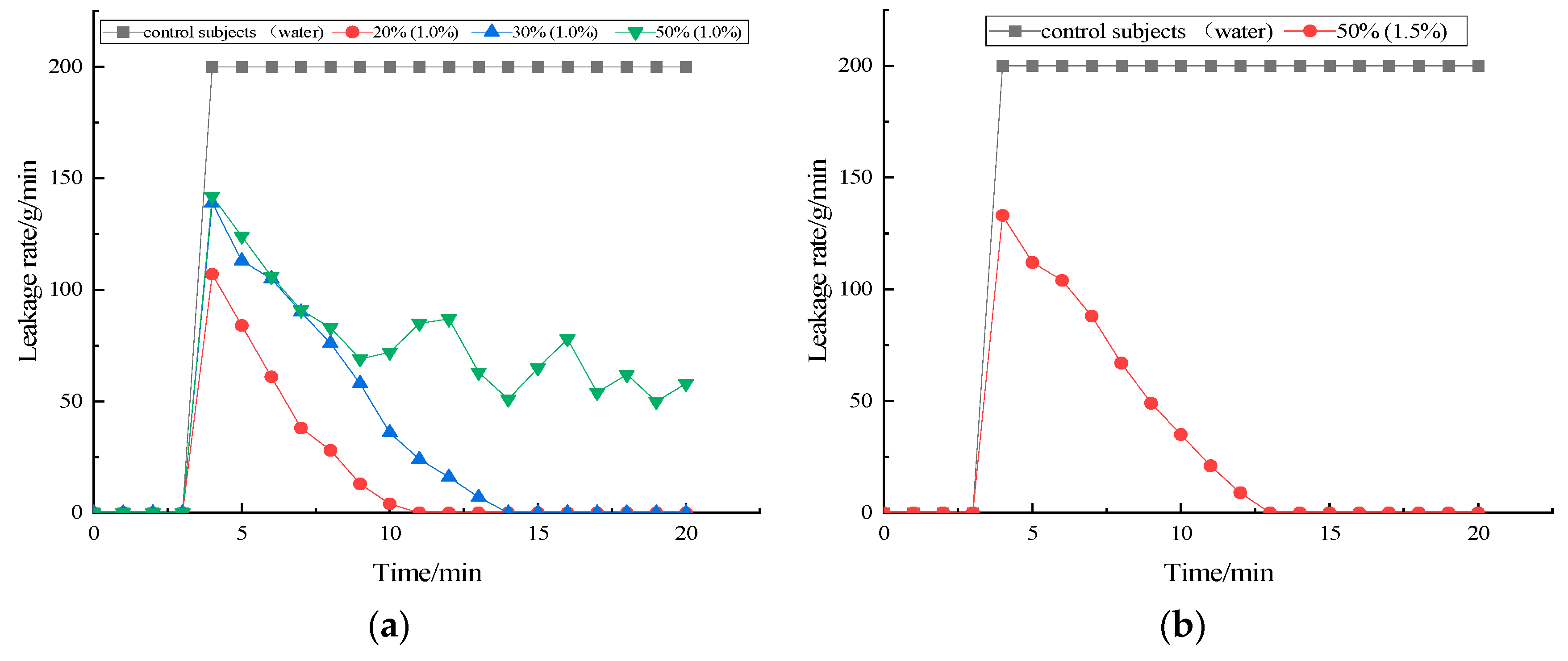
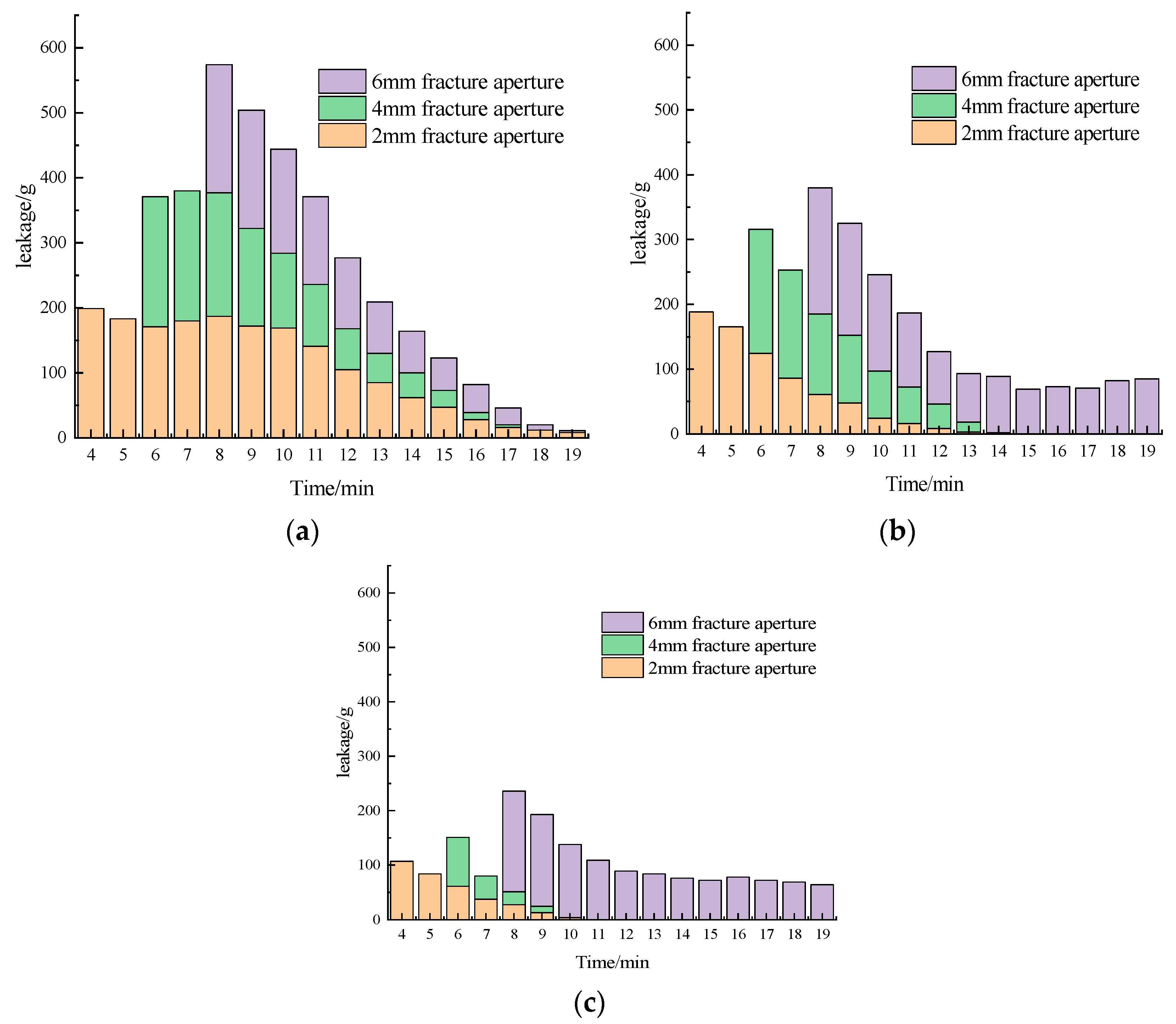
| Particle Size | Film Covering Ratio | Full Expansion Time/min | 2 mm/4 mm/6 mm Diffusion Time Within the Fracture/min | 2 mm/4 mm/6 mm Mixing Time Before Grouting/min |
|---|---|---|---|---|
| 20 mesh | 20% | 9 | 2/4/6 | 7/5/3 |
| 30% | 16 | 2/4/6 | 14/12/10 | |
| 50% | 22 | 2/4/6 | 20/18/16 | |
| 40 mesh | 20% | 6 | 2/4/6 | 4/2/0 |
| 30% | 10 | 2/4/6 | 8/6/4 | |
| 50% | 18 | 2/4/6 | 16/14/12 | |
| 60 mesh | 20% | 3 | 2/4/6 | 1/0/0 |
| 30% | 5 | 2/4/6 | 3/1/0 | |
| 50% | 8 | 2/4/6 | 6/4/2 |
Disclaimer/Publisher’s Note: The statements, opinions and data contained in all publications are solely those of the individual author(s) and contributor(s) and not of MDPI and/or the editor(s). MDPI and/or the editor(s) disclaim responsibility for any injury to people or property resulting from any ideas, methods, instructions or products referred to in the content. |
© 2024 by the authors. Licensee MDPI, Basel, Switzerland. This article is an open access article distributed under the terms and conditions of the Creative Commons Attribution (CC BY) license (https://creativecommons.org/licenses/by/4.0/).
Share and Cite
Xuan, D.; Ning, X.; Lu, K.; Li, J.; Xu, J. Delayed-Expansion Capsule Sealing Material for Coal Mine Overburden Isolated Grouting. Appl. Sci. 2024, 14, 11595. https://doi.org/10.3390/app142411595
Xuan D, Ning X, Lu K, Li J, Xu J. Delayed-Expansion Capsule Sealing Material for Coal Mine Overburden Isolated Grouting. Applied Sciences. 2024; 14(24):11595. https://doi.org/10.3390/app142411595
Chicago/Turabian StyleXuan, Dayang, Xiaoming Ning, Kaifang Lu, Jian Li, and Jialin Xu. 2024. "Delayed-Expansion Capsule Sealing Material for Coal Mine Overburden Isolated Grouting" Applied Sciences 14, no. 24: 11595. https://doi.org/10.3390/app142411595
APA StyleXuan, D., Ning, X., Lu, K., Li, J., & Xu, J. (2024). Delayed-Expansion Capsule Sealing Material for Coal Mine Overburden Isolated Grouting. Applied Sciences, 14(24), 11595. https://doi.org/10.3390/app142411595





